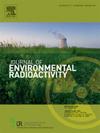Machine learning techniques for the prediction of indoor gamma-ray dose rates – Strengths, weaknesses and implications for epidemiology
IF 2.1
3区 环境科学与生态学
Q3 ENVIRONMENTAL SCIENCES
引用次数: 0
Abstract
We investigate methods that improve the estimation of indoor gamma ray dose rates at locations where measurements had not been made. These new predictions use a greater range of modelling techniques and larger variety of explanatory variables than our previous examinations of this subject. Specifically, we now employ three types of machine learning models in addition to the geostatistical, nearest neighbour and other earlier models. A large number of parameters, mostly describing the characteristics of dwellings in the area in question, have been added to the set of explanatory variables. The use of machine learning methods results in significantly improved predictions over earlier models. The machine learning models are noisy and there is some instability in the relative importance of particular explanatory variables although there are general and consistent tendencies supporting the importance of certain classes of variable. However, the range of predicted indoor gamma ray dose rates is much smaller than that of the measurements. It is probable that epidemiological studies using such predictions will have lower statistical power than those based on direct measurements.
用于室内伽马射线剂量率预测的机器学习技术——优势、劣势和对流行病学的影响。
我们研究的方法,以提高室内伽马射线剂量率的估计,在没有测量的地方。这些新的预测使用了更广泛的建模技术和更多种类的解释变量,而不是我们之前对这一主题的研究。具体来说,除了地质统计学模型、最近邻模型和其他早期模型外,我们现在还使用了三种类型的机器学习模型。在解释变量集合中加入了大量参数,这些参数大多描述了有关地区的住宅特征。与早期模型相比,机器学习方法的使用显著改善了预测结果。机器学习模型是嘈杂的,并且在特定解释变量的相对重要性方面存在一些不稳定性,尽管有一般和一致的趋势支持某些类别变量的重要性。然而,室内伽马射线剂量率的预测范围比测量结果小得多。使用这种预测的流行病学研究可能比基于直接测量的研究具有更低的统计能力。
本文章由计算机程序翻译,如有差异,请以英文原文为准。
求助全文
约1分钟内获得全文
求助全文
来源期刊

Journal of environmental radioactivity
环境科学-环境科学
CiteScore
4.70
自引率
13.00%
发文量
209
审稿时长
73 days
期刊介绍:
The Journal of Environmental Radioactivity provides a coherent international forum for publication of original research or review papers on any aspect of the occurrence of radioactivity in natural systems.
Relevant subject areas range from applications of environmental radionuclides as mechanistic or timescale tracers of natural processes to assessments of the radioecological or radiological effects of ambient radioactivity. Papers deal with naturally occurring nuclides or with those created and released by man through nuclear weapons manufacture and testing, energy production, fuel-cycle technology, etc. Reports on radioactivity in the oceans, sediments, rivers, lakes, groundwaters, soils, atmosphere and all divisions of the biosphere are welcomed, but these should not simply be of a monitoring nature unless the data are particularly innovative.
 求助内容:
求助内容: 应助结果提醒方式:
应助结果提醒方式:


